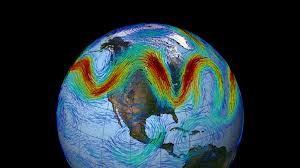How do Jet Streams Work
Jet streams are currents of fast-moving air that can be found high in the atmosphere of some planets. Here on Earth, when we refer to ‘the jet stream’, we’re typically talking about either of the polar jet streams. There are also weaker, subtropical jet streams located higher up in the atmosphere, but their altitude means they have less of an effect on commercial air traffic and the weather systems in more populated areas.
The northern jet stream travels at about 161-322 kilometres (100-200 miles) per hour from west to east, ten kilometres (six miles) above the surface in a region of the atmosphere that is known as the tropopause (the border between the troposphere and the stratosphere). It’s created by a combination of our planet’s rotation, atmospheric heating from the Sun and the Earth’s own heat from its core creating temperature differences and, therefore, pressure gradients along which air rushes.
In the northern hemisphere, the position of the jet stream can affect the weather by bringing in or pushing away the cold air from the poles. Generally, if it moves south, the weather can turn rather wet and windy; too far south and it will become much colder than usual. The reverse is true if the jet stream moves north, inducing drier and hotter weather than average as warm air moves in from the south.
 In the southern hemisphere, meanwhile, the jet stream tends to be weakened by a smaller temperature contrast created by the greater expanse of flat, even ocean surface. However, on occasion it can also impact the weather in exactly the same way as the northern jet stream does.
In the southern hemisphere, meanwhile, the jet stream tends to be weakened by a smaller temperature contrast created by the greater expanse of flat, even ocean surface. However, on occasion it can also impact the weather in exactly the same way as the northern jet stream does.
Winds of change
Currents in the jet stream travel at various speeds, but the wind is at its greatest velocity at the centre, where jet streaks can reach speeds as fast as 322 kilometres (200 miles) per hour. Pilots are trained to work with these persistent winds when flying at jet stream altitude, but wind shear is a dangerous phenomenon that they must be ever vigilant of. This is a sudden, violent change in wind direction and speed that can happen in and around the jet stream, affecting even winds at ground level. A sudden gust like this can cause a plane that’s taking off/landing to crash, which is why wind shear warning systems are equipped as standard on all commercial airliners.
The Discover and Impact of the Jet Stream
